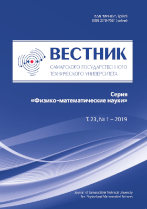|
Mathematical Modeling, Numerical Methods and Software Complexes
Mathematical modeling of coalescence and breakage of droplets and bubbles in an isotropic turbulent flow: A review
G. I. Kelbaliyeva, S. R. Rasulovb
a Institute of Catalysis and Inorganic Chemistry, Azerbaijan National Academy of Sciences, Baku, AZ 1143, Azerbaijan
b Azerbaijan State University of Oil and Industry, Baku, AZ 1010, Azerbaijan
(published under the terms of the Creative Commons Attribution 4.0 International License)
Abstract:
This review devoted to the theoretical analysis, calculation, and modeling of the processes of merging and breakage of droplets and bubbles in an isotropic turbulent flow. We have analyzed a number of studies on these issues. The problems of determining the minimum and maximum sizes of droplets and bubbles, as well as breakage and merging frequencies, which are associated with the solution of the diffusion equation of mass transfer, are considered. The merging of droplets is considered as a result of the thinning of the interfacial film formed by two drops as a result of their collision. A mathematical description of the refinement of the interfacial film, taking into account the Marangoni effect, is proposed. Analysis of many studies, including our own, showed that, depending on the scale of turbulent pulsations, the extreme size, as well as the frequencies of coalescence and breakage of droplets and bubbles, depend on the specific dissipation energy in the turbulent flow, on their sizes and on the physical properties of the particles and the medium. Important parameters that provide aggregative stability of a liquid-liquid or liquid-gas type dispersion medium to breakage, deformation and fusion are the surface tension coefficient and energy dissipation, the physical properties of the medium and particles, and in an isotropic turbulent flow the ratio of the surface coefficient tension to specific energy dissipation.
Problems related to the evolution of the particle distribution function in time and size under isotropic turbulence using solutions of the Fokker–Planck stochastic equation for continuous variation of the sizes of droplets and bubbles and the integro-differential kinetic equation of coalescence and fragmentation for jump-like changes in particle sizes are also considered. A set of analytical solutions of these equations for particular cases is proposed. A more in-depth analysis based on the mathematical laws of the transport phenomena makes it possible in the standard way to calculate such systems in an approximation, such as continuous, with an infinitely small jump. It is shown that the deterministic description of these phenomena without taking into account their stochastic nature is incomplete and can lead to significant deviations from the true nature of the above processes.
The results obtained are compared with the existing experimental data on coalescence and breakage of droplets and bubbles, which showed satisfactory agreement with the calculated values.
Keywords:
mass transfer, interfacial film, energy dissipation, isotropic turbulence, surface tension, aggregative stability.
Received: December 14, 2018
Revised: March 7, 2019
Accepted: June 10, 2019
First online: October 22, 2019
Citation:
G. I. Kelbaliyev, S. R. Rasulov, “Mathematical modeling of coalescence and breakage of droplets and bubbles in an isotropic turbulent flow: A review”, Vestn. Samar. Gos. Tekhn. Univ., Ser. Fiz.-Mat. Nauki [J. Samara State Tech. Univ., Ser. Phys. Math. Sci.], 23:3 (2019), 541–581
Linking options:
https://www.mathnet.ru/eng/vsgtu1664 https://www.mathnet.ru/eng/vsgtu/v223/i3/p541
|

| Statistics & downloads: |
| Abstract page: | 602 | | Full-text PDF : | 648 | | References: | 32 |
|




 Contact us:
Contact us: Terms of Use
Terms of Use
 Registration to the website
Registration to the website Logotypes
Logotypes










 Citation in format
Citation in format 